Pull-up bands, also known as pull-up assist bands, are a simple-looking piece of kit. But do they actually work or are they just another fitness gimmick? This post explains what a pull-up band is, how to use them, and why they are effective!
Pull-up bands are a type of resistance band. One end is looped around a bar and the other end is looped around a person’s body. The band simulates the reduction of body weight and helps a beginner to do a pull-up if they cannot currently do one.
Before I tried them properly, I was doubtful about their use and application.
But they assisted me in building pulling strength as a beginner, such that eventually I was able to progress onto traditional unassisted pull-ups.
Keep reading to find out what these bands are, what they do, and why they are so effective!
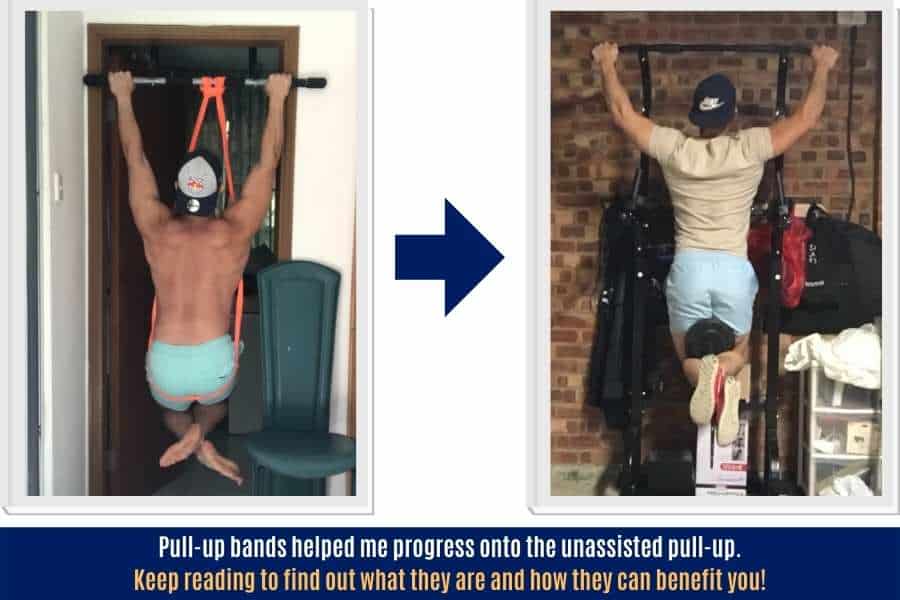
Looking For A Pull-Up Band Set?
I demonstrate what a pull-up band is and what they do, using the Undersun Fitness band set.
In my 5 years of using bands, I’ve tried them all; cheap ones, expensive ones, and those in between.
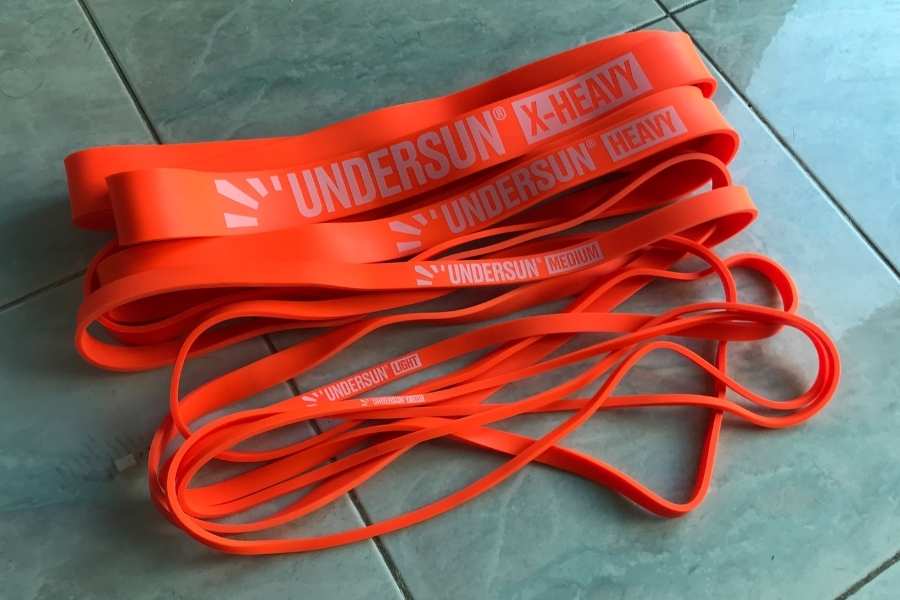
And honestly, these are the best value in my opinion.
Yup, best VALUE (not the most expensive!).
They are versatile bands that can be used for pull-up assistance as well as for regular band exercises.
You can find my full Undersun review here.
What Pull-Up Bands Are Used For
A pull-up band assists with pull-ups and chin-ups. They are mainly used by beginners who cannot yet pull their body weight to the bar without external help. Bands can also be used by experienced lifters to complete more repetitions and increase training volume.

The pull-up is an extremely effective exercise for building your back muscles and biceps.
But it’s also a notoriously difficult exercise for beginners to execute.
It requires a lot of upper-body pulling strength as well as a good technique to execute properly.
As such, a lot of newbies struggle to do even one pull-up.
Does this sound like you?
If so, then you may want to consider using pull-up assistance bands.
They help to take off some of your body weight. And this can assist a beginner tremendously in performing pull-ups.
How much weight is taken off depends on the band color and weight you use.
But generally speaking, a medium-sized band can reduce your body weight by around 50lbs (25kg).
Pull-up bands aren’t just limited to beginners though.
If you’re an experienced athlete who can already do unassisted pull-ups, adding band assistance can help you complete more reps.
This can be beneficial for increasing your total training volume and giving your muscles a different type of stimulus to adapt to.
Are Pull-Up Bands The Same As Resistance Bands?
All pull-up bands are a type of resistance band. However, not all resistance bands can be used for pull-ups. Pull-up assistance bands usually feature a loop-style design that measures 40 inches long from one end to the other.
Here are typical dimensions for the average pull-up band:
| Length: | 38-42 inches |
| Circumference: | 76-84 inches |
| Width: | 0.3-2.0 inches |
| Thickness: | 0.2 inches |
| Strength: | 5-150lbs |
Below, you can see an example of two resistance bands; one is a pull-up band the other is not.
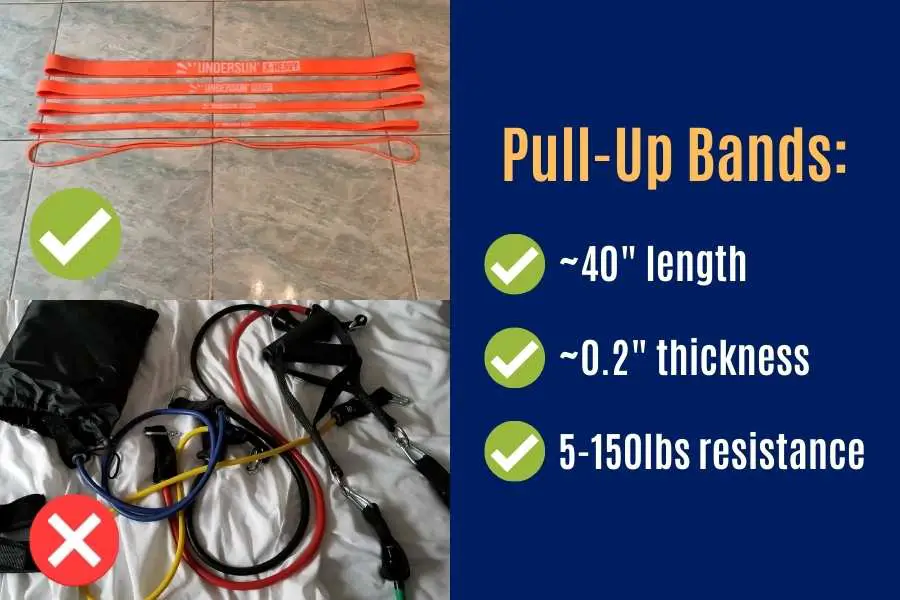
Here’s how you can tell if a resistance band is also a pull-up band:
- Approximately 40″ in length or 80″ in circumference. Allows the user to safely loop one end around the bar and the other end around the legs without the pull-up band snapping.
- Approximately 0.2″ thickness. Confers durability that’s essential since pull-up bands need to handle high levels of stretch and stress.
- 50+ lbs of resistance. Pull-up bands usually (not always) have a higher tension compared to resistance bands not designed to be used for pull-ups.
Size and tension level is the main difference between a pull-up band and a regular resistance band.
A pull-up band should be long enough and strong enough to handle a great deal of stretching during a pull-up!
If the resistance band you have is not made to be used for pull-ups, I would not use them for pull-up assistance.
This might sound obvious to some, but I know how tempting it can be to use those cheap Amazon tube-style resistance bands (the ones with the handles) for pull-ups.
Speaking from experience, this is not a good idea.
They’ll snap in no time!
For more details, you can check out my other article which explains the ideal band length, thickness, and weight for pull-ups!
How To Use A Pull-Up Assist Band
Pull-up bands are used by attaching them around the bar and body. The band is usually secured to the bar with a simple loop knot. The trailing end of the band can then be looped around the feet, thigh, or buttocks.
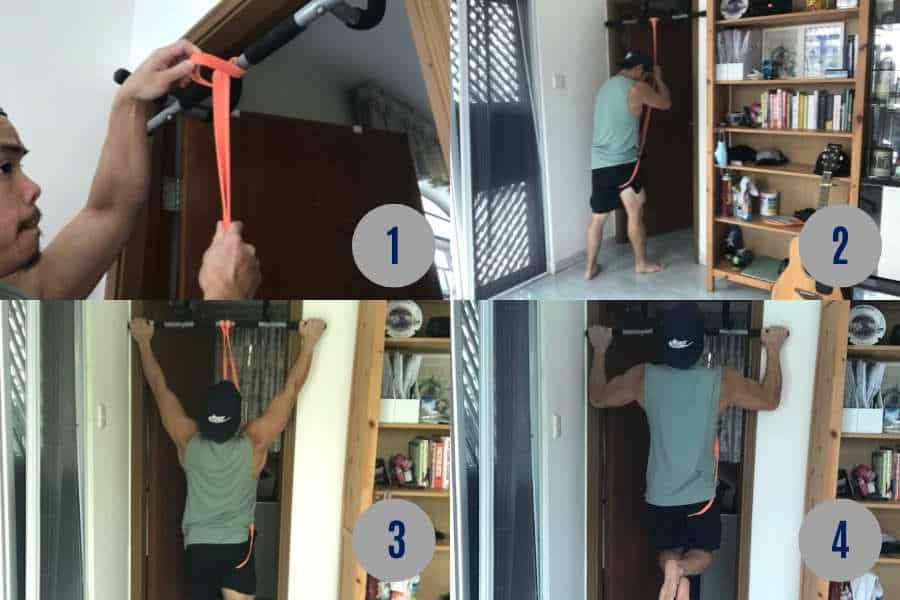
You can see an example of how to use a pull-up assist band in the picture above:
- Loop the resistance band around the bar. Thread the band through itself to create a simple loop knot.
- Pull the band downwards to tighten. The friction generated by the rubber is sufficient to secure it in place.
- Pull the trailing loop down to the knee. You want the dangling loop to be accessible to your legs.
- Step through the trailing loop. This allows the loop to sit on the soles of your feet, inside of your knees, or buttocks.
- Use the opposite leg to secure the band. Clampdown on the band to stop it from slipping.
- Perform an assisted pull-up. Now you can try doing a regular pull-up with the help of your resistance bands!
That’s the basic method on how to use a pull-up assistance band.
You can see it’s a fairly simple process.
Try looping the band around different areas of your body.
You’ll find that the lower you loop it around yourself (e.g. the feet rather than the butt), the more assistance will be provided and the more your body weight will be reduced.
Just be sure to securely clamp the band onto yourself. You don’t want it snapping back on your face!
How Pull-Up Assist Bands Works
Pull-up bands work through elasticity. As the body lowers from the pull-up bar, the band stretches and generates elastic tension. External assistance is created, and this pulls the body back up towards the bar to effectively simulate the reduction of body weight.
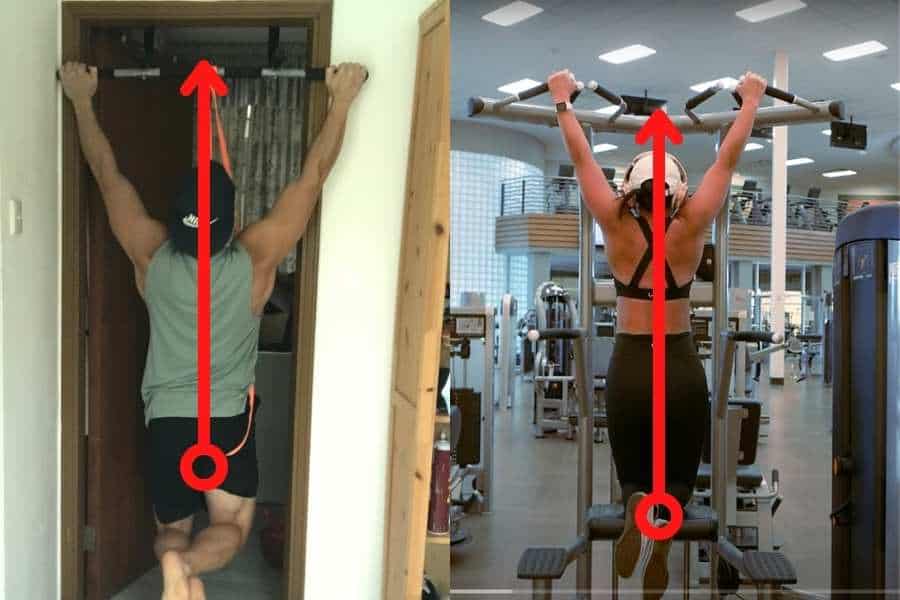
If you’ve ever used a pull-up assistance machine at the gym, you’ll have a good idea of how pull-up bands work.
They operate on the same principle; a counterweight helps to reduce your body weight.
Result?
Your body feels lighter.
This makes it easier to pull yourself up towards the bar and also easier to lower yourself away from the bar!
It’s worth noting that there’s a big difference in how the assistance feels between the band and machine assistance:
- Band-assisted pull-ups. Provides variable assistance. This increases towards the bottom of the movement when the band is at its maximal stretch.
- Machine-assisted pull-ups. Provides constant assistance. The level of assistance feels the same throughout the pull-up range of motion.
Having tried both, I felt that band-assisted pull-ups were more beneficial in helping me build my pull-up strength and develop my pull-up muscles.
Banded pull-ups can be extremely beneficial for beginners, but only when done properly.
For more information, you can check out my other article for a complete guide on what a banded pull-up is and how to use bands for pull-ups.
Are Pull-Up Assist Bands Actually Effective?
Pull-up assistance bands can work very effectively for beginners. People who cannot yet perform a pull-up can benefit greatly from the assistance provided by bands. This allows them to develop strength in the target muscles and practice the movement pattern.
There are many ways to build your pull-up strength if you cannot currently do one:
- Pull-up bands.
- Jumping pull-ups.
- Negative pull-ups.
- Dead hangs.
Therefore bands represent just one way to assist and help you on your journey to mastering the pull-up.
Whilst they can be extremely beneficial for this purpose, one thing needs to be made clear:
“Don’t use bands as an excuse to not push yourself!“
Otherwise, you won’t receive the maximum benefits.
I highly recommend using a band weight that allows you to complete 8-15 reps that actually fatigue you by the last few reps.
In other words, your muscles should feel tired by the end of each set.
Additionally, try to reduce the assistance over time by using a lighter band.
The goal is to eventually remove the pull-up band altogether!
Recommended Pull-Up Band For Beginners
I’ve been using the Undersun Fitness bands for 2 years now and highly recommend them.
Having tried plenty of competing brands in my time, I can honestly recommend these over the cheap budget brands that snap all too easily.
They’re even more durable than some of their more expensive competitors (in my experience).
This pull-up band set comes with 5 bands ranging from extra light to extra heavy.
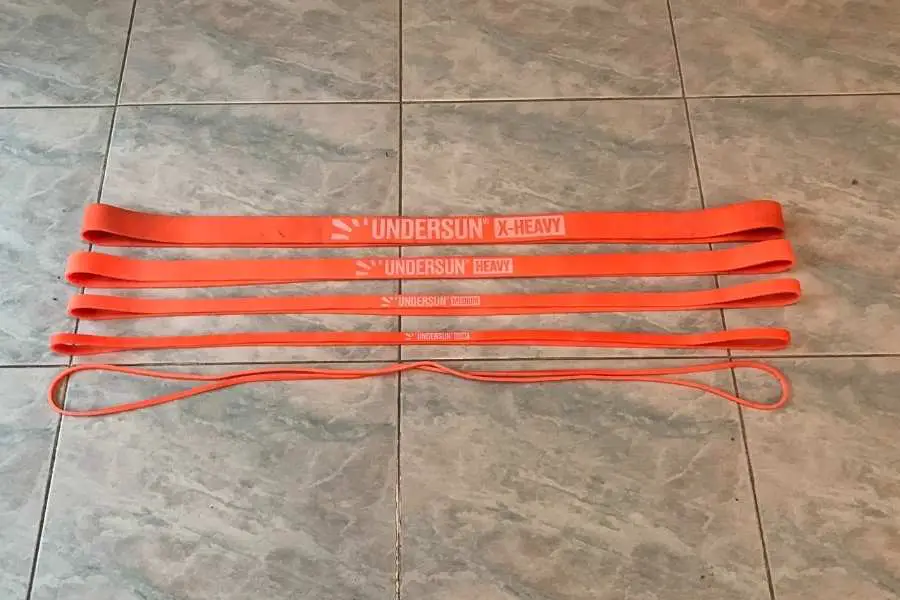
This is ideal for starting with the heavier assistance in the beginning and then progressing onto lighter assistance as you become stronger.
These are versatile bands.
They can also be used for a variety of pull-up alternative band exercises that can strengthen your back muscles if you aren’t yet ready to try the pull-up!
Conclusion
I’ve explained what a pull-up band (aka pull-up assist band) is, how to use them, how they work, and why they are effective.
These are just like any other resistance band.
But they have a slightly longer shape and can handle more weight, making them ideal for pull-up assistance.
To use them, you simply loop one end around the bar and the other end around your body.
They can help beginners who cannot yet do a pull-up, to build their pulling strength and eventually move onto unassisted pull-ups!
What do you think about the pull-up bands?
Feel free to send me a message if you have any questions! You can find my details on the “contact us” page.
You may also be interested in the downloadable Kalibre Blueprint PDF which details exactly how I gained 40lbs of lean muscle (it’s 100% free!). It details the exact exercises and nutrition (with printable worksheets) I used to go from skinny to ripped!
Thanks for reading guys!
Peace Out,
Kal
(Biochemistry BSc, Biomedical Sciences MSc, Ex-Skinny Guy)


